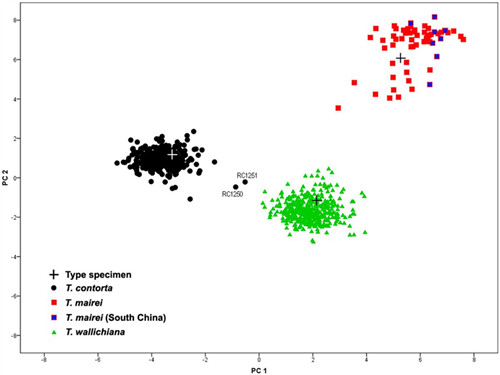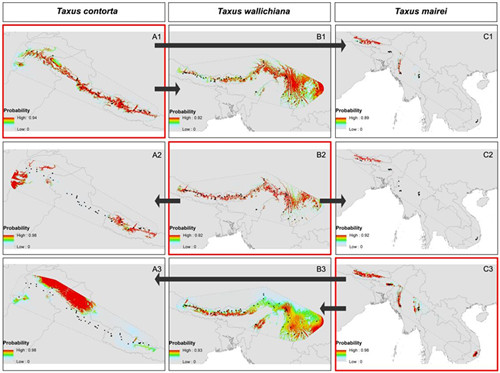Species of Taxus are very important economic plants and resources for isolation of anti-cancer drug “Taxol”. Because of excessive harvesting and commercial over-exploitation for the production of anti-cancer drugs, up to 90% of natural yew populations disappeared along the HKH over the last few decades. Despite the availability of several studies to clarify taxonomic problems on the highly threatened yews of the Hindu Kush-Himalaya (HKH) and adjacent regions, the total number of species and their exact distribution ranges remains controversial.
Recently, the Ph.D student Ram Poudel, supervised by Prof. LI Dezhu and Dr. GAO Lianming, explored the use of comprehensive sets of morphological, molecular and climatic data to clarify taxonomy and distributions of yews in this region. A total of 743 samples from 46 populations of wild yew and 47 representative herbarium specimens were analyzed. Principle component analyses on 27 morphological characters and 15 bioclimatic variables plus altitude and maximum parsimony analysis on molecular ITS and trnL-F sequences indicated the existence of three distinct species occurring in different ecological (climatic) niche and altitudinal gradients along the HKH and adjacent regions. Taxus contortafrom eastern Afghanistan to the eastern end of Central Nepal, Taxus wallichiana from the western end of Central Nepal to Northwest China, and Taxus mairei in Nepal, Bhutan, Northeast India, Myanmar and South Vietnam. The most intriguing findings of our study were the clear separation of the distributions of the yews in the HKH and adjacent regions and the first report of T. mairei in this region, a species that has previously been considered to be endemic to the South of China.
The present study has found that the three yew species are genetically distinct and can be identified easily using the combination of a few morphological characters. Furthermore ecological modeling of all three species showed that yews distributed in the HKH region not only had distinct geographic distributions but were also different in their ecological niches. Taxus contorta grows on north-facing slopes in areas with mid latitude moderate westerly winter rainfall and low summer rainfall, while Taxus wallichiana evolved with the South Asian higher summer rainfall (Indian Ocean monsoon) in habitats with predominantly south-facing aspects. Taxus mairei habitats are characterized by a great seasonality with low winter and very high summer rainfall.
In addition this study demonstrated the advantages of the combination of robust sampling and molecular, morphological and climatic data to unambiguously differentiate and identify taxonomically difficult groups. This paper has been online published in the international Journal PLoS ONE (http://www.plosone.org/article/info%3Adoi%2F10.1371%2Fjournal.pone.0046873).

Fig1. Principal component analysis (PCA) of morphological characters. PCA scatter plot of the first two coordinates based on 27 morphological characters for 743 population level samples and 47 herbarium specimens of Taxus from the Hindu Kush-Himalaya and adjacent regions. (Image by KIB)

Fig2. Ecological niche modeling. Comparison of species distribution models for A. T. contorta, B. T. wallichiana and C. T. mairei. (Image by KIB)




